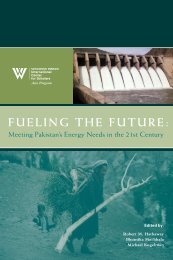Environmental Change and Security Project Report - Woodrow ...
Environmental Change and Security Project Report - Woodrow ...
Environmental Change and Security Project Report - Woodrow ...
Create successful ePaper yourself
Turn your PDF publications into a flip-book with our unique Google optimized e-Paper software.
The book’s analyses of environment <strong>and</strong><br />
security linkages are livelier. The Bangladesh<br />
chapter by A. Atiq Rahman, Zahid H.<br />
Chowdhury, <strong>and</strong> Ahsan U. Ahmed establishes<br />
four categories of linkages: national sovereignty,<br />
livelihoods, health, <strong>and</strong> ecology. The Pakistan<br />
chapter uses a model of direct effects (those<br />
based on institutional gaps <strong>and</strong> failures) <strong>and</strong><br />
indirect effects (those that operate through<br />
poverty). Both of these models are useful organizing<br />
tools <strong>and</strong> yield greater insights than the<br />
survey sections. However, given the book’s<br />
empirical m<strong>and</strong>ate, these models are not fully<br />
developed, <strong>and</strong> the diversity of approaches prevents<br />
cross-country comparisons. While Najam<br />
praises this analytical eclecticism for producing<br />
a broader range of findings, the chapters’<br />
empirical material might have benefited from<br />
more theoretical cogency.<br />
The case studies shed the burden of comprehensiveness<br />
in search of explanatory depth. For<br />
example, Rahman et al. recount the remarkable<br />
story of a misguided <strong>and</strong> mismanaged dam on<br />
Bangladesh’s Karnaphuli River that pushed an<br />
indigenous community out of their forest<br />
refuge, leading to a quarter century of armed<br />
conflict that ultimately threatened Bangladesh’s<br />
political stability. Similarly, Sarath W.<br />
Kotagama’s case-rich chapter on Sri Lanka<br />
describes a community displaced by a national<br />
park, illustrating the occasionally antagonistic<br />
relationship between the environment <strong>and</strong><br />
human security.<br />
Ajaya Dixit <strong>and</strong> Dipak Gyawali’s chapter on<br />
Nepal is worthy of separate comment; it<br />
eschews the survey approach in favor of a<br />
human security argument centered on multiple<br />
“securities in conflict,” which are tied to perceptions<br />
of risk <strong>and</strong> mechanisms for coping with it.<br />
The authors convincingly recommend using<br />
institutional pluralism to negotiate these disparate<br />
notions of security.<br />
The remaining three chapters discuss natural<br />
resources—energy, l<strong>and</strong>, <strong>and</strong> water—in the<br />
context of environment <strong>and</strong> development. In<br />
their tightly structured discourse on energy <strong>and</strong><br />
security, Najam <strong>and</strong> Kumudu Gunasekera outline<br />
“energy paths” over time <strong>and</strong> organize them<br />
by efficiency, energy dependence, <strong>and</strong> environmental<br />
security. The graphs illustrating the<br />
chapter capture, at a glance, patterns across<br />
South Asia.<br />
Khalid Saeed’s chapter on l<strong>and</strong> use projects<br />
food <strong>and</strong> l<strong>and</strong>-related trends for 14 countries<br />
using a system dynamics model. Even though<br />
the model’s structure is presented diagrammatically,<br />
it is hard to underst<strong>and</strong>. Moreover,<br />
even though more recent data are available,<br />
the inputs date from 1987. It is hard to<br />
believe the author’s claim that an additional<br />
decade of data would not affect the results.<br />
Perhaps most problematically, Saeed does not<br />
delve any deeper than country-level data,<br />
which is particularly egregious in a human<br />
security framework. For example, an analysis<br />
of different consumer classes’ access to food<br />
under conditions of stress would have added<br />
to his argument.<br />
Ramaswamy R. Iyer’s chapter on water<br />
begins intriguingly by warning that applying a<br />
security framework to environmental problems<br />
could be dangerous. Instead of improving security,<br />
he fears, the interaction may damage environmental<br />
discourse. In his discussion of flood<br />
management, water quality, <strong>and</strong> water sharing,<br />
Iyer limits his use of “security” to interstate relationships.<br />
However, when he addresses cooperation,<br />
he adopts a wider view, issuing an impassioned<br />
<strong>and</strong> convincing plea to escape the intellectual<br />
straitjacket of supply-side thinking that<br />
has dominated water management in South<br />
Asia for the past decades.<br />
By steering clear of theoretical debates, the<br />
volume loses some of its power to convince the<br />
reader, as illustrated by two examples drawn<br />
from the editor’s “five key lessons.” First, Najam<br />
makes a strong case that these essays demonstrate<br />
the value of locating environment <strong>and</strong><br />
security within the rubric of sustainable development.<br />
However, without exploring the literature<br />
on security, how can the reader underst<strong>and</strong><br />
why we should retain the language of security,<br />
as opposed to subsuming the entire discussion<br />
in sustainable development? Second, Najam<br />
critiques the mainstream security discourse for<br />
over-emphasizing resource abundance at the<br />
Environment,<br />
Development <strong>and</strong><br />
Human <strong>Security</strong><br />
reproaches the theoretical<br />
genuflecting<br />
that has characterized<br />
recent environmental<br />
security literature.<br />
Instead, the<br />
volume asks, what is<br />
relevant to South<br />
Asia’s on-the-ground<br />
practitioners?<br />
89<br />
NEW PUBLICATIONS

















